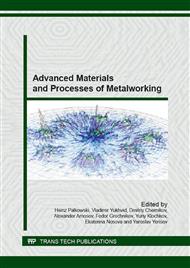[1]
Bridgman, P.W. Studies in Large Plastic Flow and Fracture. McGraw-Hill, New York, (1952).
Google Scholar
[2]
Cabezas, E.E., Celentano, D.J. Experimental and numerical analysis of the tensile test using sheet specimens. Finite Elements in Analysis and Design 40 (5–6), (2004) 555–575.
DOI: 10.1016/s0168-874x(03)00096-9
Google Scholar
[3]
Bressan, J.D., Unfer, R.K. Construction and validation tests of a torsion test machine. Journal of Materials Processing Technology 179 (1–3), (2006) 23–29.
DOI: 10.1016/j.jmatprotec.2006.03.099
Google Scholar
[4]
Lee, C.H., Altan, T. Influence of flow stress and friction upon metal flow in upset forging of ring and cylinders. Journal of Engineering for Industry – Transactions of the ASME 94 (3), (1972) 775–782.
DOI: 10.1115/1.3428250
Google Scholar
[5]
Lee, H., et al A numerical approach to spherical indentation techniques for material property evaluation. Journal of the Mechanics and Physics of Solids 53 (9), (2005) 2037–(2069).
DOI: 10.1016/j.jmps.2005.04.007
Google Scholar
[6]
Nayebi, A., Abdi, R. El., et al New procedure to determine steel mechanical parameters from the spherical indentation technique. Mechanics of Materials 34 (4), (2002) 243–254.
DOI: 10.1016/s0167-6636(02)00113-8
Google Scholar
[7]
Campitelli, E.N., Spa¨tig, P., Bonade´, R., Hoffelner, W., Victoria, M. Assessment of the constitutive properties from small ball punch test: experiment and modeling. Journal of Nuclear Materials 335 (3), (2004) 366–378.
DOI: 10.1016/j.jnucmat.2004.07.052
Google Scholar
[8]
Isselin, J. et al Assessment of the constitutive law by inverse methodology: small punch test and hardness. Journal of Nuclear Materials 352 (1–3), (2006) 97–106.
DOI: 10.1016/j.jnucmat.2006.02.076
Google Scholar
[9]
Choi, Y., et al A method of determining flow stress and friction factor by the ring compression test. In: Proceedings of the Korean Society of Mechanical Engineering 1997 Spring Annual Meeting, Chonnam National University, Republic of Korea, (1997).
Google Scholar
[10]
Kolsky, H., An Investigation of the Mechanical Properties of Materials at Very High Rates of Strain, Proc. Roy. Phys. Soc., B 62, pp.676-700 (1949).
DOI: 10.1088/0370-1301/62/11/302
Google Scholar
[11]
Gray, G. Classic split-Hopkinson bar testing. In: ASM Handbook, 12th ed., vol. 8. American Society for Metals, (2000) 462–476.
Google Scholar
[12]
Gray, G., Blumenthal, W. Split-Hopkinson pressure bar testing of soft materials. In: ASM Handbook, 12th ed., vol. 8. American Society for Metals, (2000) 488–496.
DOI: 10.31399/asm.hb.v08.a0003298
Google Scholar
[13]
R. Ebrahimi, A. Najafizadeh A new method for evaluation of friction in bulk metal forming Journal of Materials Processing Technology 152 (2004) 136–143.
DOI: 10.1016/j.jmatprotec.2004.03.029
Google Scholar
[14]
Gubkin, S.I. Deformiruemost metallov [Deformability of metals]. Moscow, Metallurgizdat. Publ., (In Russian), (1953) 199.
Google Scholar
[15]
C.H. Lee, T. Altan, Influence of flow stress and friction upon metal flow in upset forging of rings and cylinders, ASME J. Eng. Ind. 94 (1972) 775–782.
DOI: 10.1115/1.3428250
Google Scholar


